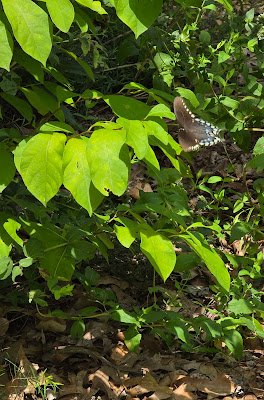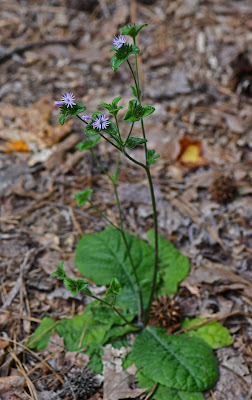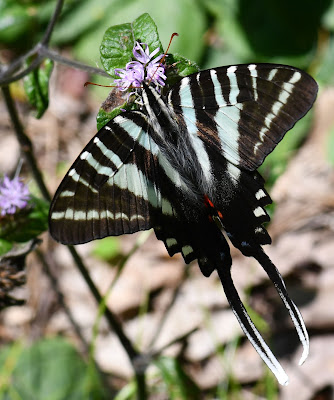What a week it's been!
Last Wednesday, an immature Cooper's Hawk (Accipiter cooperii) caught, killed, and ate a Mourning Dove (Zenaida macroura) right outside my office window. Yes, I felt bad for the dove...but the hawk has to eat, too. It seemed really hungry and stayed in that same spot, eating nonstop, for over 90 minutes.
A new species of firefly has started flashing in the yard lately, during the time immediately after dark. Unfortunately, I don't have any photos to share. We noticed them Friday night, when our cable went out due to a storm. With no internet to distract us, we sat on the front porch watching the storm - and serendipitously noticed the fireflies. This species seems to flash in a fairly long, horizontal single flash - no "J dip". I haven't been able to find an adult during the day yet; I'm hoping to so that I can try to identify which species this is.
This evening I thought I might re-enact my childhood and catch a couple in a jar, look at them up close, and then release them...but either fireflies have gotten a lot more elusive or I've gotten a lot worse at catching them. It didn't help that it was lightly raining, thunder was grumbling, and there were occasional flashes of lightning in the sky. My heart just wasn't in the project. I kept seeing headlines that read, "68 Year Old Woman Struck By Lightning As She Tried To Catch Fireflies In A Jar". I guess it would make a good family history story, though.
A new-to-the-yard firefly species would bring our yard total up to 4 different species of fireflies.
The eggs of the Eastern Bluebirds (Sialia sialis) have hatched. Not only are Mom and Dad Bluebird busy getting food for the chicks, but there's a juvenile hanging around that I think may be from an earlier clutch.
Right outside the bluebird box, the berries on our large American Pokeweed (Phytolacca americana) have started to change color, and the birds are eating them as fast as they ripen. Note the bright pink remnants of a berry cluster? THAT bunch didn't last long!
Cardinals (Cardinalis cardinalis) seem to be very common consumers, as do the Bluebirds themselves. Blue Jays (Cyanocitta cristata) tried to come in to snack on the berries, too, but the Bluebirds were having none of that, thank you very kindly. They were extremely vigorous in driving the jays away. The Bluebirds didn't seem to mind the Cardinals, though. I saw one juvenile Eastern Towhee (Pipilo erythrophthalmus) hop into the bush, but a human visitor scared him away before I could see if he was just passing through or if he was actually there to eat. And, if the latter, whether he would upset the Bluebirds.
Yesterday, I was lucky enough to see a Variegated Fritillary (Euptoieta claudia) bopping all around the back yard, laying eggs on a large number of Violets (Viola sororia). I've understood for years that violets are the host plants for fritillaries, but I've never seen any sign of caterpillars on any violets that I've grown. I'm looking forward to being a fritillary grandparent now!
The Variegated Fritillary took a few moments to relax from her labors and I was able to snap a photo - not a good one, but still enough to let you know what she looks like in general. She was about the size of a Painted Lady or Red Admiral.
Note: Apparently this species of fritillary differs from many of the other fritillary species in having additional host plants besides violets. According to iNaturalist, in our yard the other host plants would be Plantain (Plantago sp.), Mayapple (Podophyllum peltatum), and possibly Yellow Passionvine (Passiflora lutea), since 3 other Passiflora species are listed as host plants.
Shortly after I lost sight of the Variegated Fritillary, a Spicebush Swallowtail (Papilio troilus) zipped in and seemed to lay eggs on the Spicebush (Lindera benzoin) by the back shed. I was able to capture a photo of the butterfly, but I didn't catch her "in the act". Now I know, though, that I'm likely to see the folded leaves that signal Spicebush Swallowtail caterpillars in the near future.
As I meander in the yard this summer, I feel like I'm seeing an exciting increase in insect species, especially in butterflies and moths. So far this year I've seen Spicebush Swallowtails (Papilio troilus), a Pipeline Swallowtail (Battus philenor), Tulip-tree Beauties (Epimecis hortaria), 2 species of Underwing Moths, Baltimore Snouts (Hypena baltimoralis), and over 15 other moth species that are "new to the yard". Those are just the ones I've been able to take photos of that were clear enough to identify. There have been many, many more moths and butterflies than fluttered away without posing for me. And I'm only seeing the adults, the ones that weren't turned into baby birds or other animals when they were caterpillars!
I recently finished reading Oliver Milman's The Insect Crisis: The Fall of the Tiny Empires That Run the World, published in 2022. It was a sobering read and reinforced my passion for rewilding our little space, working to create a bit of habitat where native plants and insects have a chance to live and flourish.
We started caring for this yard in the fall of 2019. Over the course of that first year, I saw just a couple butterfly and skipper species - and no moths, despite being outside pulling Japanese Stiltgrass for what felt like days on end.
The difference between then and now is so incredibly heartening. It gives me hope. We've removed invasive species, left the leaves, left native seedlings that were "planted" by birds, and we've also planted more native plants. We haven't sprayed insecticides or herbicides. That's it. Nothing fancy or complicated. That's been our management plan as we try to give nature some breathing space to recover. And our yard has responded: it is infinitely more full of life now than it was 4 years ago. We CAN have a positive impact.

















































